From Iraq to the Stage
An Interview with Roman Baca
BY EMMALY WIEDERHOLT
Roman Baca, a U.S. marine veteran, is the artistic director of Exit 12 Dance Company. His choreography directly addresses conflict and draws on his experience serving in the Iraq war.
Photo by Rachel Neville
~~
How did you get into dance?
In high school, one of my best friends was a ballet dancer, and it was always something that interested me. When I moved to live with my father in Albuquerque, I had the opportunity to sign up for a dance class. Eventually I got into musical theater and danced at many studios around town to get more experience.
After dancing in Albuquerque for a few years, I had the opportunity to study at the Nutmeg Conservatory for the Arts in the pre-professional program. I spent three years there and graduated from the program before starting to work as a freelance dancer in Connecticut and New York City.
What made you decide to join the military?
I was having a pretty tough go of it in the dance world. There’s work out there for guys who can dance, but it didn’t feel sustainable. In thinking of my next step in life and what I wanted to do, I knew I wanted to try something completely different from dance. I wanted to challenge myself in a new way. I had always wanted to rise to the challenge of something like the Marine Corps. In September of 1999, I entered boot camp in the United States Marine Corps at Parris Island, South Carolina.
I spent a total of eight years in the Marine Corps, culminating with a deployment in 2006 to Fallujah, Iraq as part of Operation Iraqi Freedom.
What was the impetus that made you want to choreograph based on conflict?
Iraq was life changing. There was so much I learned from living in another culture, working with interpreters, working with the locals in the villages we were patrolling…it was a crash course in cultural diplomacy, humanitarianism and conflict resolution. We were spending our days going into the city and looking for insurgents. Marine Corps training dictated we do that as effectively and violently as possible in order to ward people off and make them understand we were not easy targets for attack. However, operating at this tempo was not engendering us to the locals. They would not give us information and were hesitant to cooperate, so we started to develop a humanitarian side to the mission. We came across a small little school with 12 kids in it, very rustic, and so the next time we went out, we brought them school supplies. Every time we went out after that we made sure to hand out food and water to the locals. This was why I had joined the Marine Corps; I wanted to help people. I wanted to make a difference.
Coming back from war after Fallujah and having my views and morals challenged, I was at a loss of what direction to go in. I followed the example my grandfather had set when he got back from the Korean War: I found a job and devoted myself to being with my girlfriend. About six months into that, my girlfriend sat me down and said I was not okay. She told me I was angry, anxious, depressed, and not the guy she knew before the war. It wasn’t an easy thing to hear.
She also asked me: if you could do anything in this world, without worrying about time or money, what would you do? I told her I had always wanted to start a dance company.
Photo by Tracy Dorman
I started by working with my girlfriend and her best friend. We rented space in Manhattan, put together choreography, videotaped it, and sent it off to different luminaries in the field and choreographic competitions. We were falling on deaf ears, but one of the things I had learned from the Marine Corps was persistence and determination. With every submission, I would follow up. Finally, Stephen Mills from Ballet Austin got back to me and lent an ear. The most important advice he gave me was I needed to find that one thing in me that was burning to be addressed. For me, that was the military experience.
We opened up our choreographic lens to the military experience and approached it from the angle that nobody else talks about: the monotony, the effects of the war at home, and the effects of the war on locals.
Is your choreography abstract or literal?
When we started, it was hyper literal. I wanted to create an atmosphere that transported the audience to Iraq. Our first piece started in a totally black theater. Two little red lights started to dance on the scrim. Then the audience realized the lights were from laser target designators on top of M16s that the marines carry. We actually had two marines start at the back of the audience and come down the aisles. While they were coming down the aisles, the Arabic call to prayer was playing. We were trying to replicate the fear of seeing people with live weapons walking around. This was in 2007, and we probably could not do that today in the current gun climate. Then the piece became more extract, juxtaposed with projections of images from marines overseas, and radio traffic audio combined with a Schumann piano sonata. The dancers represented that which keeps the marines connected to home and their families.
Our piece after that, Homecoming, was even more literal. We took violin orchestrations and layered it with actors reading letters to and from my buddies in the marines. The piece was about the effect serving overseas has on loved ones back home.
Then we started to become a little more abstract. Conflicted shows two members in the military and two women in abayas. It represents those from completely different cultures trying to interact while there are cultural and political stigmas keeping them apart.
Photo by Andy Hart
Then other choreographers started contacting us. One choreographer had two sons overseas, and choreographed a retrospective piece about watching them grow up and get deployed. Another choreographer came in and did a piece about home from the perspective of Homer’s Odyssey. We started to build a repertoire that addresses conflict.
The dancers you work with are mostly classically trained. How do you get them to enter the mindset necessary for your work?
Most of our dancers have been with us for five years or longer. They’ve been immersed in this type of art. We do talk-backs after our performances, and what the dancers have said to that question is that they’ve experienced my journey through my choreography. Bit by bit, I explain intention, texture and motivation. That’s helped them frame it.
The dancers have been with us to the Walter Reed military hospital, the Palo Alto VA and the New Haven VA. Through speaking with veterans and dancing with them through our veteran movement workshops, they’ve made connections.
There are several dancers with a direct veteran connection. My wife was my girlfriend through my whole deployment and has seen my journey back. Another dancer who joined the company five years ago said she approached the work as honorably as she could, but felt she couldn’t get to the emotional place that accurately told the stories we were trying to tell. Then her brother joined the army and was deployed to Afghanistan. Her change in emotional layering with regards to our work was complete; she knew what it felt like to have someone you love serving in a warzone.
What kinds of audiences have you performed for, and what reactions have you received?
We’ve hit a lot of different audience bases. The audiences where we seem to be best received are the veteran audiences, as well as audiences with some sort of connection to art and healing. Those audiences already have some background knowledge of the veteran experience.
Photo by Jud Schultz
We performed at the 92nd Street Y, the iconic modern dance institution, for a mixed audience in a program called Movement Talks. It was done interview style with a moderator asking me questions. Interspersed within the answers were the dances, so it was like a lecture demo. Our fans were there, but there were also people who just came because it’s the 92nd Street Y. One of the parents of a dancer overheard someone mutter, “I just hate veterans.” It was a negative comment toward the veteran experience.
We get reactions of all kinds, from people who connect to our work to others who think the whole experience is politically wrong and motivationally wrong. There are different negative reactions; it would be one thing for people to not like or understand a piece, but the negative reactions we usually get are toward a group of people and their experiences. One NY Times reviewer said we were trying to generate sympathy for a misled war. Rather than looking at the piece as art, they tried to translate it into a political issue.
Is there room and hunger for more dance that addresses the military experience?
Yes and no. We’re hitting a niche of a genre that no one else is doing. We’re bringing the experience of conflict to audiences. There’s not a market for it; most of our performances are places that already contextualize the veteran experience or focus on art and healing. But I think it’s important.
Starting the company, we thought we were going to bring our hard-hitting choreography that was relevant and timely, rife with all this inspiration people could use to advocate for change or peace. There were all these reasons we thought people would want to see our work. But the reason we do it now is very different than why we started. The reason we do it now and why we believe it is important is because art like this shows us the way out of mire. It shows us the bottom of what can happen in this world. But, along with that, we are very conscious about putting something at the end of our programs that show the way out of the tunnel.
When I went back to Iraq as a dance teacher, we designed a piece about hope, the future, and how we all want the same things. Most of us want a good job, to settle down with someone we really care about, and to walk down the street and do what we enjoy without fear. The art of showing the darkness and opening up to the light is so important. Art can show that the world has problems, but if you can’t imagine a better world, then it will never be realized.
And have you personally found some sense of understanding and healing through your work?
Absolutely.
A couple years ago, my work with the company slowed because I was doing other things. The people who are closest to me noticed a significant change in my demeanor and wellbeing. A couple close friends suggested I get back to the company, and they were right. It’s getting into the studio and moving that helps turn the darkness into light.
Photo by Derek Torrellas
~~

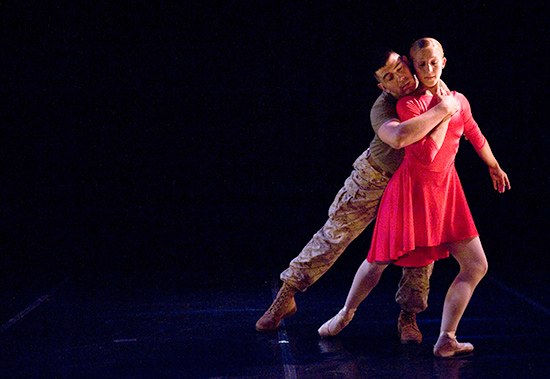
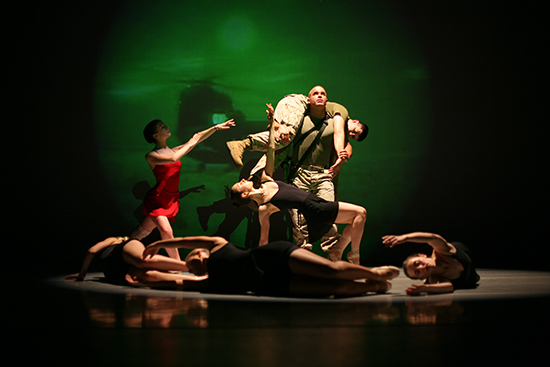
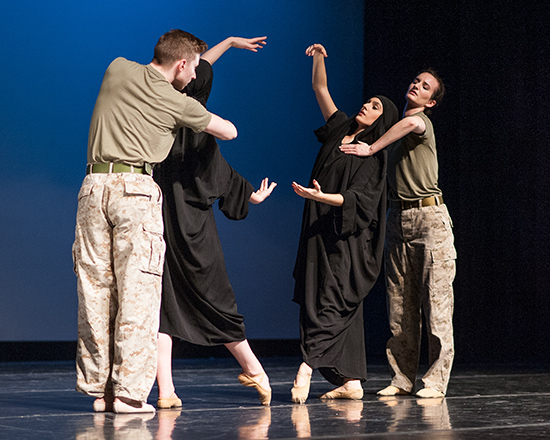
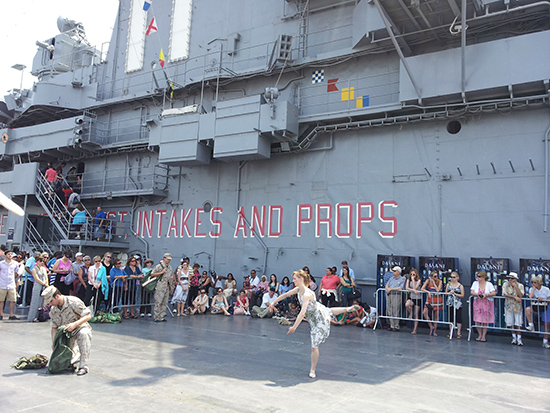
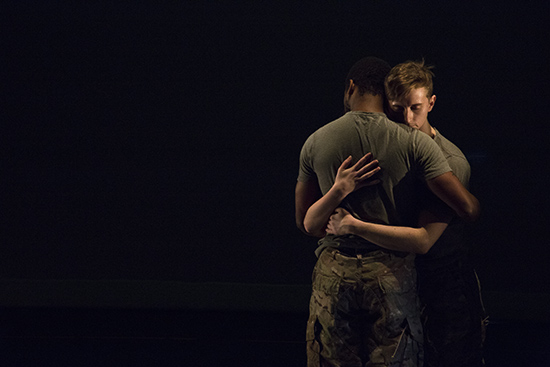
One Response to “From Iraq to the Stage”
Awesome. Thank you for sharing.
Keep going!
Comments are closed.